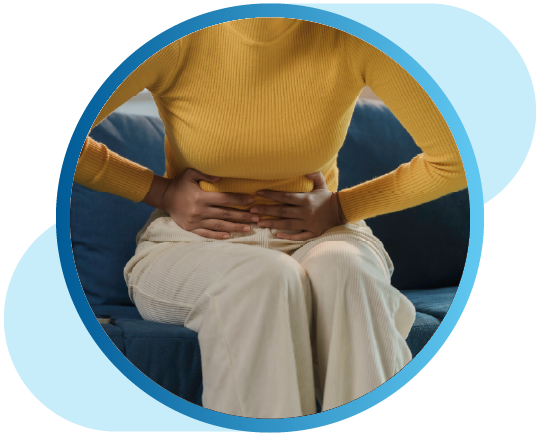
What are uterine fibroids?
Fibroids are non-cancerous growths that form in or around the uterus. They can range in size from very small (like a pea) to quite large (like a grapefruit), sometimes distorting the shape of the uterus.
While some women never notice symptoms, others experience heavy bleeding, pelvic pain, and fertility challenges. The good news is that fibroids are highly treatable—and you don’t always need surgery to find relief.
The role of the uterus and how fibroids develop
The uterus is a muscular organ designed for menstruation and pregnancy. When certain cells grow abnormally, fibroids form. Hormones such as estrogen and progesterone often encourage fibroid growth.
Fibroid causes
The exact cause is not fully understood, but risk factors include:
- Family history of fibroids
- Hormonal changes (pregnancy, menopause, birth control)
- Obesity or high BMI
- Vitamin D deficiency
- Race and ethnicity (Black women are more likely to develop fibroids)
- Environmental factors, such as exposure to endocrine-disrupting chemicals
Fibroid symptoms
Fibroid symptoms vary in type and severity, but may include:
- Heavy or prolonged menstrual bleeding
- Severe cramps or pelvic pressure
- Frequent urination or urinary incontinence
- Painful intercourse
- Back or leg pain
- Constipation and bloating
- Fatigue or anemia caused by blood loss
- Infertility or pregnancy complications

How fibroids impact daily life and fertility
Fibroids can limit social activities, disrupt intimacy, and make everyday routines difficult. They may also interfere with pregnancy, sometimes contributing to infertility or miscarriage.
Fibroid types
The location of fibroids determines their type:
- Subserosal Fibroids: Form on the outside of the uterus and may press on nearby organs.
- Pedunculated Fibroids: Connected to the uterus by a stalk-like growth; twisting can cause sharp pain.
- Calcified Fibroids: Harden as calcium builds up, making them more difficult to manage.
- Submucosal Fibroids: Grow beneath the uterine lining, often leading to heavy bleeding and fertility issues.
- Intramural Fibroids: Develop in the muscular uterine wall, causing pain and menstrual irregularities.
Signs it’s time to seek care for fibroids
You should see a doctor if you experience:
- Heavy bleeding that disrupts daily life
- Prolonged or painful periods
- Fatigue or anemia
- Ongoing pelvic pain or pressure
- Difficulty getting pregnant
- Noticeable abdominal swelling
If fibroid symptoms interfere with your health or quality of life, it’s time to explore treatment options.
Uterine Fibroid Embolization: A minimally invasive treatment option
Uterine fibroid embolization (UFE) is a safe and effective non-surgical treatment for fibroids, performed by interventional radiologists.
How embolization works for fibroids
- A tiny catheter is guided into the blood vessels that feed the fibroids.
- Microscopic particles are released to block the blood supply.
- Without blood flow, fibroids shrink and symptoms improve.
UFE is an outpatient procedure that usually takes about an hour. Most patients go home the same day and return to normal activities within 1–2 weeks.
The benefits of UFE
According to the Society of Interventional Radiology, nearly 9 in 10 women experience significant improvement after undergoing UFE—with far less downtime compared to surgery.
Many women choose UFE because it offers:
- Outpatient treatment with same-day discharge
- No major surgery or large incisions
- Shorter recovery compared to hysterectomy or myomectomy
- Relief from heavy bleeding, pelvic pain, and pressure
- Preservation of the uterus and potential fertility
Discover a safer path to fibroid relief
With uterine fibroid embolization, you don’t need major surgery to find freedom from heavy bleeding, pelvic pain, and pressure. This outpatient procedure offers faster recovery, preserves the uterus, and delivers effective, lasting results.
Take our UFE Quiz to see if this treatment may be right for you.
UFE vs. Traditional Approaches
Treatment | Invasiveness | Recovery Time | Preserves Uterus | Effectiveness |
|---|---|---|---|---|
UFE | Minimally invasive | 1–2 weeks | ✅ Yes | High |
Myomectomy | Surgical | 4–6 weeks | ✅ Yes | High |
Hysterectomy | Major surgery | 6–8 weeks | ❌ No | Permanent |
Medications | Non-invasive (oral) | Ongoing use | ✅ Yes | Limited |
| Endometrial Ablation | Minimally invasive | 2–3 weeks | ✅ Yes, but it affects fertility | Moderate |
Why choose Texas Endovascular for fibroid care
Every patient receives compassionate, personalized treatment that focuses on long-term relief, improved health, and a better quality of life.
- Fellowship-trained interventional radiologists deliver expert care using the latest minimally invasive treatments for fibroids.
- We rely on state-of-the-art imaging technology to plan and guide each procedure with precision, ensuring safer and more effective outcomes.
- Our convenient clinic locations across Houston and Dallas–Fort Worth make it easier for women throughout Texas to access advanced fibroid care close to home.
Experience advanced fibroid care in Texas
Fibroids are common, but you don’t have to live with painful symptoms.
At Texas Endovascular, we help women find lasting relief with advanced, non-surgical fibroid treatment options, such as UFE.







